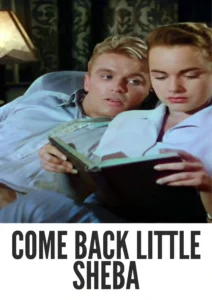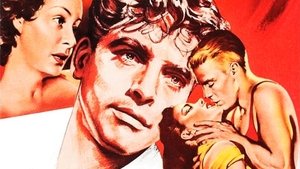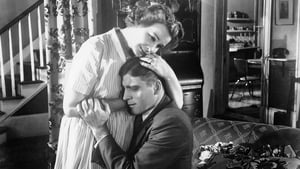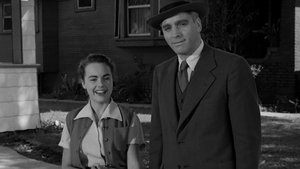Video Sources 0 Views
- Watch trailer
- Come Back Little Sheba 1952 Colorized


Synopsis
Table of Contents
Toggle
Delve into the heart of a crumbling marriage with Come Back, Little Sheba, a poignant marital drama from 1952, now beautifully colorized for a revitalized viewing experience. Starring Burt Lancaster and Shirley Booth, this film, directed by Daniel Mann, presents a raw and unflinching look at addiction, regret, and the yearning for lost youth. Perfect for those seeking emotionally resonant stories and stellar performances, this HD download offers a chance to rediscover a powerful and often overlooked cinematic gem.
Come Back, Little Sheba tells the story of Doc Delaney (Burt Lancaster), a recovering alcoholic chiropractor, and his frumpy, infantilized wife, Lola (Shirley Booth). Their once-passionate marriage has devolved into a strained and resentful co-existence, haunted by the ghost of “Little Sheba,” a lost puppy that symbolizes Lola’s lost youth and unfulfilled dreams.
The arrival of Marie (Terry Moore), a vibrant young college student and boarder, disrupts the Delaneys’ fragile equilibrium. Marie’s youth and beauty ignite Doc’s repressed desires and fuel Lola’s insecurities, pushing their marriage to the breaking point. As Doc battles his inner demons and Lola grapples with her loneliness, the film explores themes of addiction, aging, and the destructive power of unspoken resentments. The film builds to a harrowing climax as Doc relapses into alcoholism, forcing Lola to confront the devastating consequences of their shared past. Ultimately, Come Back, Little Sheba is a powerful and moving exploration of the complexities of marriage and the struggle for redemption.
The film boasts unforgettable performances from its cast:
-
Burt Lancaster as Doc Delaney
-
Shirley Booth as Lola Delaney
-
Terry Moore as Marie Buckholder
-
Richard Jaeckel as Turk Fisher
-
Wendy Barrie as Mrs. Coffman
Come Back, Little Sheba is a moving character-driven marital drama, with elements of melodrama and psychological realism. It delves into the inner lives of its characters, exploring their vulnerabilities, their desires, and their capacity for both love and destruction.
Released in 1952, Come Back, Little Sheba reflects the anxieties and tensions of post-war American society. The film tackles taboo subjects such as alcoholism and marital dissatisfaction, offering a glimpse into the changing social mores of the era. Shirley Booth’s portrayal of Lola Delaney resonated deeply with audiences, earning her an Academy Award for Best Actress. The film’s success also paved the way for other realistic and unflinching portrayals of domestic life on screen.
This colorized version of Come Back, Little Sheba has been carefully restored, enhancing the emotional impact of the story while retaining the film’s original atmosphere. The colorization process involved a detailed analysis of the original black and white footage, with meticulous attention paid to accurately representing the characters’ costumes, the setting of the Delaney’s home, and the overall mood of each scene. The goal was to enhance the storytelling, adding depth and nuance to the performances and themes, making it even more accessible to contemporary audiences. This careful transformation seeks to honor the film’s legacy while ensuring its continued relevance for future generations.
-
: Daniel Mann
-
: Ketti Frings
-
: the play by William Inge
-
: James Wong Howe
-
: Warren Low
-
: Paramount Pictures
-
: Paramount Pictures
-
: 99 minutes
-
: MP4
-
: HD (1080p)
-
: Compatible with most devices, including smartphones, tablets, computers, and smart TVs.
Come Back, Little Sheba (1952) is celebrated for its powerful performances, particularly Shirley Booth’s Oscar-winning portrayal of Lola Delaney. Critics praised the film’s unflinching exploration of addiction, marital strife, and the complexities of human relationships. Over the years, the film has gained a reputation as a poignant and insightful drama that continues to resonate with audiences today. It stands as a testament to the power of realistic storytelling and the enduring appeal of human dramas.
-
: What is Come Back, Little Sheba about?
-
A: Come Back, Little Sheba is a marital drama about a troubled couple grappling with addiction, regret, and lost dreams.
-
-
: What makes Come Back, Little Sheba a significant film?
-
A: The film is notable for its realistic portrayal of marital issues, Shirley Booth’s Oscar-winning performance, and its exploration of taboo subjects for its time.
-
-
: Is this version of Come Back, Little Sheba colorized?
-
A: Yes, this version has been professionally colorized to enhance the viewing experience.
-
-
: What are the main themes explored in Come Back, Little Sheba?
-
A: The film explores themes of addiction, marital dissatisfaction, aging, and the impact of the past on the present.
-
-
: What is the download format?
-
A: The download format is MP4, which is compatible with most devices.
-
-
: What resolution is the download?
-
A: The resolution is HD (1080p), providing a high-quality viewing experience.
-
Experience Come Back, Little Sheba Today!











